Pandemic Boosts Prospects for Recovery of Rural Tourism in Serbia
Abstract
1. Introduction
2. Literature Review and Hypotheses Development
2.1. A Theoretical Approach to the Relationship between the Pandemic and the Rural Environment
2.2. The Quality of Service in Rural Households as a Booster for the Recovery of Tourism
3. Methodology
3.1. Choice of Methodological Approach and Measurements
3.2. Sample and Data Collection
3.3. Data Analysis
4. Results and Discussion
4.1. Results of IPA Analysis
4.2. Results of Classification of Dimensions and Positive Prediction Based on Cutoff Scores
4.3. ARIMA Model Results
5. Conclusion with Limitations and Future Implications
5.1. Theoretical Implications
5.2. Practical Implications
Author Contributions
Funding
Data Availability Statement
Acknowledgments
Conflicts of Interest
References
- Baum, T.; Nguyen, H.T.T. Hospitality, tourism, human rights and the impact of COVID-19. Int. J. Contemp. Hosp. Manag. 2020, 32, 2397–2407. [Google Scholar] [CrossRef]
- Ministry of Trade, Tourism and Telecommunications. Available online: https://arhiva.mtt.gov.rs/en/ (accessed on 15 December 2022).
- Gössling, S.; Scott, D.; Hall, C.M. Pandemics, tourism and global change: A rapid assessment. J. Sustain. Tour. 2020, 29, 1–20. [Google Scholar] [CrossRef]
- Wu, T.M.; Xu, J.; Wong, S.M. Crisis management research (1985–2020) in the hospitality and tourism industry: A review and research agenda. Tour. Manag. 2021, 85, 104307. [Google Scholar] [CrossRef]
- Yang, J.; Yang, R.; Chen, M.-H.; Su, C.-H.J.; Zhi, Y.; Xi, J. Effects of rural revitalization on rural tourism. J. Hosp. Tour. Manag. 2021, 7, 35–45. [Google Scholar] [CrossRef]
- Mugauina, R.; Rey, I.Y.; Sabirova, R.; Rakhisheva, A.B.; Berstembayeva, R.; Beketova, K.N.; Zhansagimova, A. Development of rural tourism after the coronavirus pandemic. J. Environ. Manag. Tour. 2020, 11, 2020–2027. Available online: https://journals.aserspublishing.eu/jemt/article/view/5805 (accessed on 15 December 2022).
- Seo, B.R.; Kim, K.L. The Post Pandemic Revitalization Plan for the Medical Tourism Sector in South Korea: A Brief Review. Iran. J. Public Health 2021, 50, 1766–1772. [Google Scholar] [CrossRef]
- Wen, J.; Kozak, M.; Yang, S.; Liu, F. COVID-19: Potential effects on Chinese citizens’ lifestyle and travel. Tour. Rev. 2020, 76, 74–87. [Google Scholar] [CrossRef]
- Rebola, F.; Loures, L.; Ferreira, P.; Loures, A. Inland or Coastal: That’s the Question! Different Impacts of COVID-19 on the Tourism Sector in Portugal. Sustainability 2022, 14, 16248. [Google Scholar] [CrossRef]
- Coroş, M.M.; Bode, O.R.; Săvan, E.E.; Ciucioiu, T.A. Rural Tourism During the COVID-19 Pandemic: A Case Study from North-Western Transylvania. Stud. Univ. Babeş-Bolyai Negot. 2021, 66, 7–22. [Google Scholar] [CrossRef]
- Peira, G.; Longo, D.; Pucciarelli, F.; Bonadonna, A. Rural tourism destination: The Ligurian Farmers’ perspective. Sustainability 2021, 13, 13684. [Google Scholar] [CrossRef]
- Rosalina, P.D.; Dupre, K.; Wang, Y. Rural tourism: A systematic literature review on definitions and challenges. J. Hosp. Tour. Manag. 2021, 47, 134–149. [Google Scholar] [CrossRef]
- Lane, B. Sustainable rural tourism strategies: A tool for development and conservation. J. Sustain. Tour. 1994, 2, 102–111. [Google Scholar] [CrossRef]
- Frochot, I. A benefit segmentation of tourists in rural areas: A Scottish perspective. Tour. Manag. 2005, 26, 335–346. [Google Scholar] [CrossRef]
- Molera, L.; Albaladejo, P. Profiling segments of tourists in rural areas of south-eastern Spain. Tour. Manag. 2007, 28, 757–767. [Google Scholar] [CrossRef]
- Park, D.; Yoon, Y. Segmentation by motivation in rural tourism: A Korean case study. Tour. Manag. 2009, 30, 99–108. [Google Scholar] [CrossRef]
- Bielska, A.; Borkowski, A.S.; Czarnecka, D.M.; Malina, J.K.; Piotrkowska, M. Evaluating the potential of suburban and rural areas for tourism and recreation, including individual short-term tourism under pandemic conditions. Sci. Rep. 2022, 12, 20369. [Google Scholar] [CrossRef]
- Wang, L.; Yotsumoto, Y. Conflict in tourism development in rural China. Tour. Manag. 2019, 70, 188–200. [Google Scholar] [CrossRef]
- Shrestha, R.K.; L’Espoir Decosta, P. Developing dynamic capabilities for community collaboration and tourism product innovation in response to crisis: Nepal and COVID-19. J. Sustain. Tour. 2021, 31, 168–186. [Google Scholar] [CrossRef]
- Silva, L. The impact of the COVID-19 pandemic on rural tourism: A case study from Portugal. Anatolia 2022, 33, 157–159. [Google Scholar] [CrossRef]
- Yang, J.; Zhu, G. The Recovery Strategy of Rural Tourism in the Post-Epidemic Period. Advances in Social Science, Education and Humanities Research. In Proceedings of the 2021 International Conference on Social Sciences and Big Data Application (ICSSBDA 2021), Xi’an, China, 10–12 December 2021; Atlantis Press: Paris, France, 2021. [Google Scholar] [CrossRef]
- Marques, C.P.; Guedes, A.; Bento, R. Rural tourism recovery between two COVID-19 waves: The case of Portugal. Curr. Issues Tour. 2021, 25, 857–863. [Google Scholar] [CrossRef]
- Osman, Z.; Sentosa, I. Mediating Effect of Customer Satisfaction on Service Quality and Customer Loyalty Relationship in Malaysian Rural Tourism. Int. J. Econ. Bus. Manag. Stud. 2013, 2, 25–37. Available online: https://papers.ssrn.com/sol3/papers.cfm?abstract_id=2196815 (accessed on 20 November 2022).
- Vaishar, A.; Št’astná, M. Impact of the COVID-19 pandemic on rural tourism in Czechia preliminary considerations. Curr. Issues Tour. 2020, 25, 187–191. [Google Scholar] [CrossRef]
- Li, L.; Tao, Z.; Lu, L. Understanding differences in rural tourism recovery: A critical study from the mobility perspective. Curr. Issues Tour. 2022, 1, 1368–3500. [Google Scholar] [CrossRef]
- Wang, J.; Wang, Y.; He, Y.; Zhu, Z. Exploring the Factors of Rural Tourism Recovery in the Post-COVID-19 Era Based on the Grounded Theory: A Case Study of Tianxi Village in Hunan Province, China. Sustainability 2022, 14, 5215. [Google Scholar] [CrossRef]
- Cró, S.; Martins, A.M. Structural breaks in international tourism demand: Are they caused by crises or disasters? Tour. Manag. 2017, 63, 3–9. [Google Scholar] [CrossRef]
- Aithal, R.; Anil, R.K.; Angmo, D. Rural tourism in India: Case studies of resilience during crisis. Worldw. Hosp. Tour. 2022, 15, 63–73. [Google Scholar] [CrossRef]
- Phillipson, J.; Gorton, M.; Turner, R.; Shucksmith, M.; Aitken-cDermott, K.; Areal, F.; Cowie, P.; Hubbard, C.; Maioli, S.; McAreavey, R.; et al. The COVID-19 pandemic and its implications for rural economies. Sustainability 2020, 12, 3973. [Google Scholar] [CrossRef]
- Chatzigeorgiou, C.; Simeli, I. Delegate Satisfaction. Service quality, satisfaction, future behavioural intentions. J. Tour. Herit. Serv. Mark. 2020, 6, 3–8. [Google Scholar] [CrossRef]
- N’Drower, F.; Moscardo, G.; Murphy, L. Tourism brings good things: Tourism and community development in rural Papua New Guinea. Tour. Rev. Int. 2021, 25, 229–245. [Google Scholar] [CrossRef]
- Seraphin, H.; Dosquet, F. Mountain tourism and second home tourism as post COVID-19 lockdown placebo? Worldw. Hosp. Tour. Themes 2020, 12, 485–500. [Google Scholar] [CrossRef]
- Chuang, S.T. Residents’ attitudes toward rural tourism in Taiwan: A comparative viewpoint. Int. J. Tour. Res. 2013, 15, 152–170. [Google Scholar] [CrossRef]
- Hwang, J.; Lee, S. The effect of the rural tourism policy on non-farm income in South Korea. Tour. Manag. 2015, 46, 501–513. [Google Scholar] [CrossRef]
- Gajić, T.; Vukolić, D.; Petrović, M.; Blešić, I.; Zrnić, M.; Cvijanović, D.; Sekulić, D.; Spasojević, A.; Obradović, A.; Obradović, M.; et al. Risks in the Role of Co-Creating the Future of Tourism in “Stigmatized” Destinations. Sustainability 2022, 14, 15530. [Google Scholar] [CrossRef]
- Albacete-Sáez, C.A.; Mar Fuentes-Fuentes, M.; Javier Lloréns-Montes, F. Service quality measurement in rural accommodation. Ann. Tour. Res. 2007, 34, 45–65. [Google Scholar] [CrossRef]
- Choi, H.; Ann, S.; Lee, K.W.; Park, D.B. Measuring Service Quality of Rural Accommodations. Sustainability 2018, 10, 443. [Google Scholar] [CrossRef]
- Augustyn, M.; Ho, S.K. Service quality and tourism. J. Travel Res. 1998, 37, 71–75. [Google Scholar] [CrossRef]
- Sharpley, R. Rural tourism and the challenge of tourism diversification: The case of Cyprus. Tour. Manag. 2002, 23, 233–244. [Google Scholar] [CrossRef]
- Wos, B.; Gawlik, A.; Drobek, W. Obiekty hotelarskie na terenach wiejskich—Nowa jakość usług (Hotel enterprises in rural areas—New quality of services). Study Obsz. Wiej. 2018, 49, 173–185. Available online: https://rcin.org.pl/dlibra/publication/86996/edition/67966/obiekty-hotelarskie-na-terenach-wiejskich-nowa-jakosc-uslug-hotel-enterpri (accessed on 20 November 2022). [CrossRef]
- Št’astná, M.; Vaishar, A.; Brychta, J.; Tuzová, K.; Zloch, J.; Stodolová, V. Cultural tourism as a driver of rural development. case study: Southern Moravia. Sustainability 2020, 12, 9064. [Google Scholar] [CrossRef]
- Fanelli, R.M.; Romagnoli, L. Customer satisfaction with farmhouse facilities and its implications for the promotion of agritourism resources in Italian municipalities. Sustainability 2020, 12, 1749. [Google Scholar] [CrossRef]
- Blaine, T.; Golam, M.; Var, T. Demand for Rural Tourism: An Exploratory Study. Ann. Tour. Res. 1993, 20, 770–773. [Google Scholar] [CrossRef]
- Fleischer, A.; Pizam, A. Rural Tourism in Israel. Tour. Manag. 1997, 18, 367–372. [Google Scholar] [CrossRef]
- Yague, P.R. Rural Tourism in Spain. Ann. Tour. Res. 2002, 29, 1101–1110. [Google Scholar] [CrossRef]
- Tian-Cole, S.; Crompton, J. A Conceptualization of the Relationships between Service Quality and Visitor Satisfaction, and their Links to Destination Selection. Leis. Stud. 2003, 22, 65–80. [Google Scholar] [CrossRef]
- Wojciechowska-Solis, J.; Smiglak-Krajewska, M.; Viti, D. Identification of the Quality Gaps in the Services Offered in Accommodation Facilities in Rural Areas: The Case of the Lublin Region. Sustainability 2022, 14, 16873. [Google Scholar] [CrossRef]
- Yoon, Y.; Uysal, M. An examination of the effects of motivation and satisfaction on destination loyalty: A structural model. Tour. Manag. 2003, 26, 45–56. [Google Scholar] [CrossRef]
- Chi, C.G.-Q.; Qu, H. Examining the structural relationships of destination image, tourist satisfaction and destination loyalty: An integrated approach. Tour. Manag. 2008, 29, 624–663. [Google Scholar] [CrossRef]
- Rahimizhian, S.; Avci, T.; Eluwole, K.K. A conceptual model development of the impact of higher education service quality in guaranteeing edu-tourists’ satisfaction and behavioral intentions. J. Public Aff. 2020, 20, e2085. [Google Scholar] [CrossRef]
- Puri, G.; Singh, K. The role of service quality and customer satisfaction in tourism industry: A review of SERVQUAL Model. Int. J. Res. Anal. Rev. 2018, 5, 745–751. Available online: http://ijrar.com/upload_issue/ijrar_issue_20542271.pdf (accessed on 20 November 2022).
- Marković, S.; Kljaic Šebrek, J. Service Quality Measurement in Rural Tourism: Application of RURALQUAL Model. Acad. Tur. Tour. Innov. J. 2020, 13, 215–227. [Google Scholar] [CrossRef]
- Parasuraman, A.; Zeithaml, V.A.; Berry, L.L. A conceptual model of service quality and its implications for future research. J. Mark. 1985, 49, 41–50. Available online: https://www.jstor.org/stable/1251430 (accessed on 15 December 2022). [CrossRef]
- Loureiro, S.M.C.; González, F.J.M. The importance of quality, satisfaction, trust, and image in relation to rural tourist loyalty. J. Travel Tour. Mark. 2008, 25, 117–136. [Google Scholar] [CrossRef]
- Ennew, C.T.; Reed, G.V.; Binks, M.R. Importance-performance analysis and the measurement of service quality. Eur. J. Mark. 1993, 27, 59–70. [Google Scholar] [CrossRef]
- Deng, W. Using a revised importance–performance analysis approach: The case of Taiwanese hot springs tourism. Tour. Manag. 2007, 28, 1274–1284. [Google Scholar] [CrossRef]
- Hudson, S.; Shephard, G. Measuring service quality at tourist destinations: An application of importance performance analysis to an Alpine Ski Resort. J. Travel Tour. Mark. 1998, 7, 61–68. [Google Scholar] [CrossRef]
- Babakus, E.; Boller, G.W. An empirical assessment of the SERVQUAL scale. J. Bus. Res. 1992, 24, 253–268. [Google Scholar] [CrossRef]
- Zhou, B.; Qi, F.; Riaz, M.F.; Ali, T. An Analysis of the Factors behind Rural Residents’ Satisfaction with Residential Waste Management in Jiangxi, China. Int. J. Environ. Res. Public Health 2022, 19, 14220. [Google Scholar] [CrossRef]
- Jiang, X.; Sheng, X. A study on the development strategy of rural residential accommodation in Suzhou based on customer satisfaction. J. Sha Chau Polytech. 2020, 23, 18–23. [Google Scholar] [CrossRef]
- Wang, G.-L.; Liu, C.-C.; Tseng, S.-R. An evaluation of Taiwanese B & B service quality using the IPA model. J. Bussiness Res. Turk 2012, 4, 20–27. Available online: https://isarder.org/index.php/isarder/article/view/76/73 (accessed on 20 November 2022).
- Đoković, F.; Pejanović, R.; Mojsilović, M.; Đorđević Boljanović, J.; Plećić, K. Possibilities of revitalization of rural tourism in the functioning of agricultural cooperatives. Econ. Agric. 2017, 64, 1115–1132. [Google Scholar] [CrossRef]
- Cvijanović, D.; Gajić, T. The Level of Engagement of the Female Workforce in the Rural Tourism Development of Serbia. J. Tour. Leis. Hosp. 2020, 2, 36–42. Available online: https://dergipark.org.tr/en/pub/toleho/issue/53785/739476 (accessed on 20 November 2022).
- Cohen, E. A phenomenology of tourist experiences. Sociology 1979, 13, 179–201. [Google Scholar] [CrossRef]
- Loureiro, S.M.C.; González, F.J.M. Perceived quality in rural lodgings in Spain and Portugal: The RURALQUAL scale. Port. J. Manag. Stud. 2009, 14, 33–52. Available online: https://econpapers.repec.org/article/pjmjournl/v_3axiv_3ay_3a2009_3ai_3a1_3ap_3a33-52.htm (accessed on 15 December 2022).
- Grönroos, C. A Service Quality Model and its Marketing Implications. Eur. J. Mark. 1984, 18, 36–44. [Google Scholar] [CrossRef]
- Parasuraman, A.; Berry, L.L.; Zeithaml, V.A. Refinement and reassessment of the SERVQUAL scale. J. Retail. 1991, 67, 420. [Google Scholar] [CrossRef]
- Taplin, R.H. Competitive importance-performance analysis of an Australian wildlife park. Tour. Manag. 2012, 33, 29–37. [Google Scholar] [CrossRef]
- Oh, H. Revisiting importance-performance analysis. Tour. Manag. 2021, 22, 617–627. [Google Scholar] [CrossRef]
- Bacon, D.R. A comparison of approaches to importanceperformance analysis. Int. J. Mark. Reserch 2003, 45, 55–73. [Google Scholar] [CrossRef]
- Sörensson, A.; Von Friedrichs, Y. An importance-performance analysis of sustainable tourism: A comparison between international and national tourists. J. Destin. Mark. Manag. 2013, 2, 14–21. [Google Scholar] [CrossRef]
- Hu, M.L.M.; Yen, C.D.; Horng, J.S. Assessing students’ low carbon literacy by Ridit IPA approach. J. Hosp. Leis. Sport Tour. Educ. 2013, 13, 202–2012. [Google Scholar] [CrossRef]
- Martilla, J.; James, J.C. Important-performance analysis. J. Mark. 1997, 41, 13–17. [Google Scholar] [CrossRef]
- Zsóka, Á. Consistency and “awareness gaps” in the environmental behaviour of Hungarian companies. J. Clean. Prod. 2008, 16, 322–329. [Google Scholar] [CrossRef]
- Fawcett, T. An Introduction to ROC Analysis. Pattern Recognit. Lett. 2008, 27, 861–874. [Google Scholar] [CrossRef]
- Box, G.E.; Jenkins, G.M.; Reinsel, G.C. Time Series Analysis: Forecasting and Control, 3rd ed.; Prentice Hall: Hoboken, NJ, USA, 1994; ISBN 1001-3060-7746592. Available online: https://www.scirp.org/(S(i43dyn45teexjx455qlt3d2q))/reference/ReferencesPapers.aspx?ReferenceID=1936224 (accessed on 20 November 2022).
- Chinazzi, M.; Davis, J.T.; Ajelli, M.; Gioannini, C.; Litvinova, M.; Merler, S.; Viboud, C. The effect of travel restrictions on the spread of the 2019 novel coronavirus (COVID-19) outbreak. Science 2020, 368, 395–400. [Google Scholar] [CrossRef]
- Tseng, K.C.; Lin, H.H.; Lin, J.W.; Chen, I.S.; Hsu, C.H. Under the COVID-19 Environment, Will Tourism Decision Making, Environmental Risks, and Epidemic Prevention Attitudes Affect the People’s Firm Belief in Participating in Leisure Tourism Activities? Int. J. Environ. Res. Public Health 2021, 18, 7539. [Google Scholar] [CrossRef]
- Newbery, R.; Bosworth, G. Home-based business sectors in the rural economy. Soc. Bus. Rev. 2010, 5, 183–197. [Google Scholar] [CrossRef]
- Brouder, P. Reset redux: Possible evolutionary pathways towards the transformation of tourism in a COVID-19 world. Tour. Geogr. 2020, 22, 484–490. [Google Scholar] [CrossRef]
- Farmaki, A. Memory and forgetfulness in tourism crisis research. Tour. Manag. 2021, 83, 104210. [Google Scholar] [CrossRef]
- Higgins-Desbiolles, F. Socialising tourism for social and ecological justice after COVID-19. Tour. Geogr. 2020, 22, 610–623. [Google Scholar] [CrossRef]
- Akgün, A.A.; Baycan, T.; Nijkamp, P. Rethinking on sustainable rural development. Eur. Plan. Stud. 2015, 23, 678–692. [Google Scholar] [CrossRef]
- Kürüm Varolgüne, F.; Çelik, F.; Del Río-Rama, M.C.; Álvarez-García, J. Reassessment of sustainable rural tourism strategies after COVID-19. Front. Psychol. 2022, 13, 944412. [Google Scholar] [CrossRef] [PubMed]
- Aliperti, G.; Sandholz, S.; Hagenlocher, M.; Rizzi, F.; Frey, M.; Garschagen, M. Tourism, crisis, disaster: An interdisciplinary approach. Ann. Tour. Res. 2019, 79, 102808. [Google Scholar] [CrossRef]
- Song, H.; Livat, F.; Ye, S. Effects of terrorist attacks on tourist flows to France: Is wine tourism a substitute for urban tourism? J. Destin. Mark. Manag. 2019, 14, 100385. [Google Scholar] [CrossRef]
- Zawadka, J.; Jęczmyk, A.; Uglis, J.; Wojcieszak-Zbierska, M.M. Plany turystyczne mieszkańców miast w dobie pandemii COVID-19. Warsztaty Z Geogr. Turyzmu 2021, 11, 13–34. [Google Scholar] [CrossRef]
- Vinerean, S.; Opreana, A.; Tileaga, C.; Popsa, R.E. The impact of COVID-19 pandemic on residents’ support for sustainable tourism development. Sustainability 2021, 13, 12541. [Google Scholar] [CrossRef]
- Vuković, D.B.; Zobov, A.M.; Degtereva, E.A. The Nexus Between Tourism and Regional Real Growth: Dynamic Panel Threshold Testing. J. Geogr. Inst. “Jovan Cvijić” SASA 2022, 71, 111–116. [Google Scholar] [CrossRef]
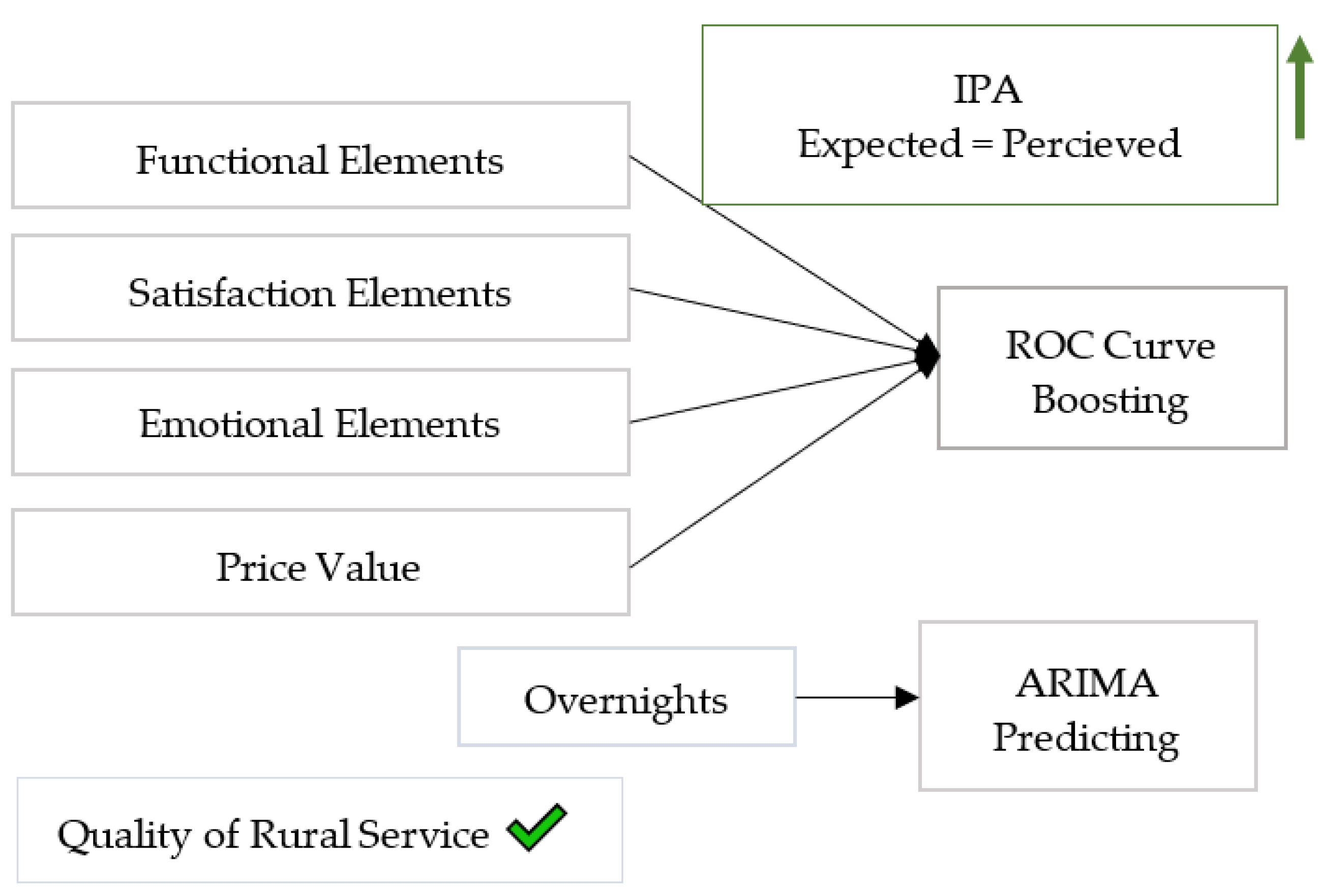
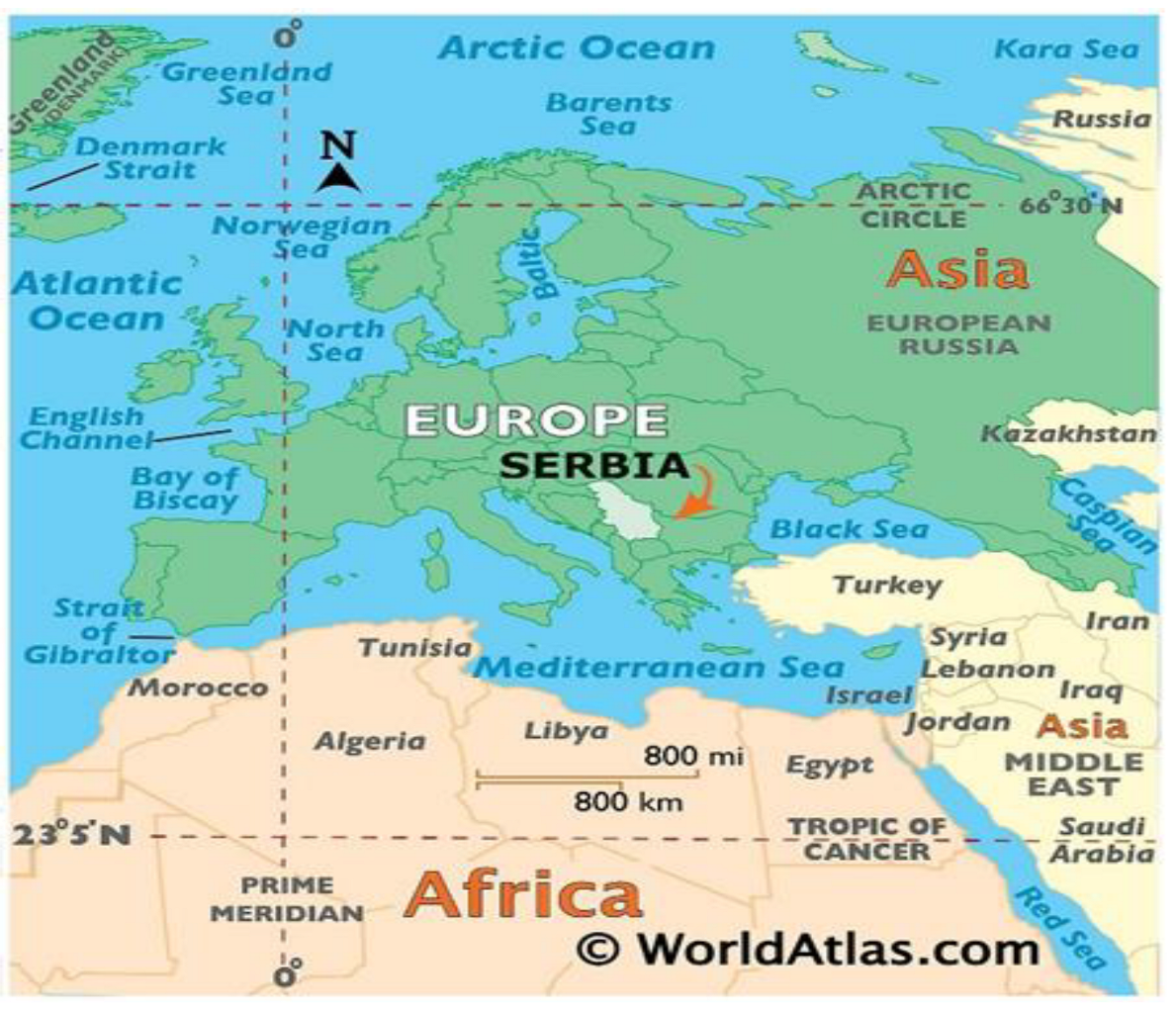



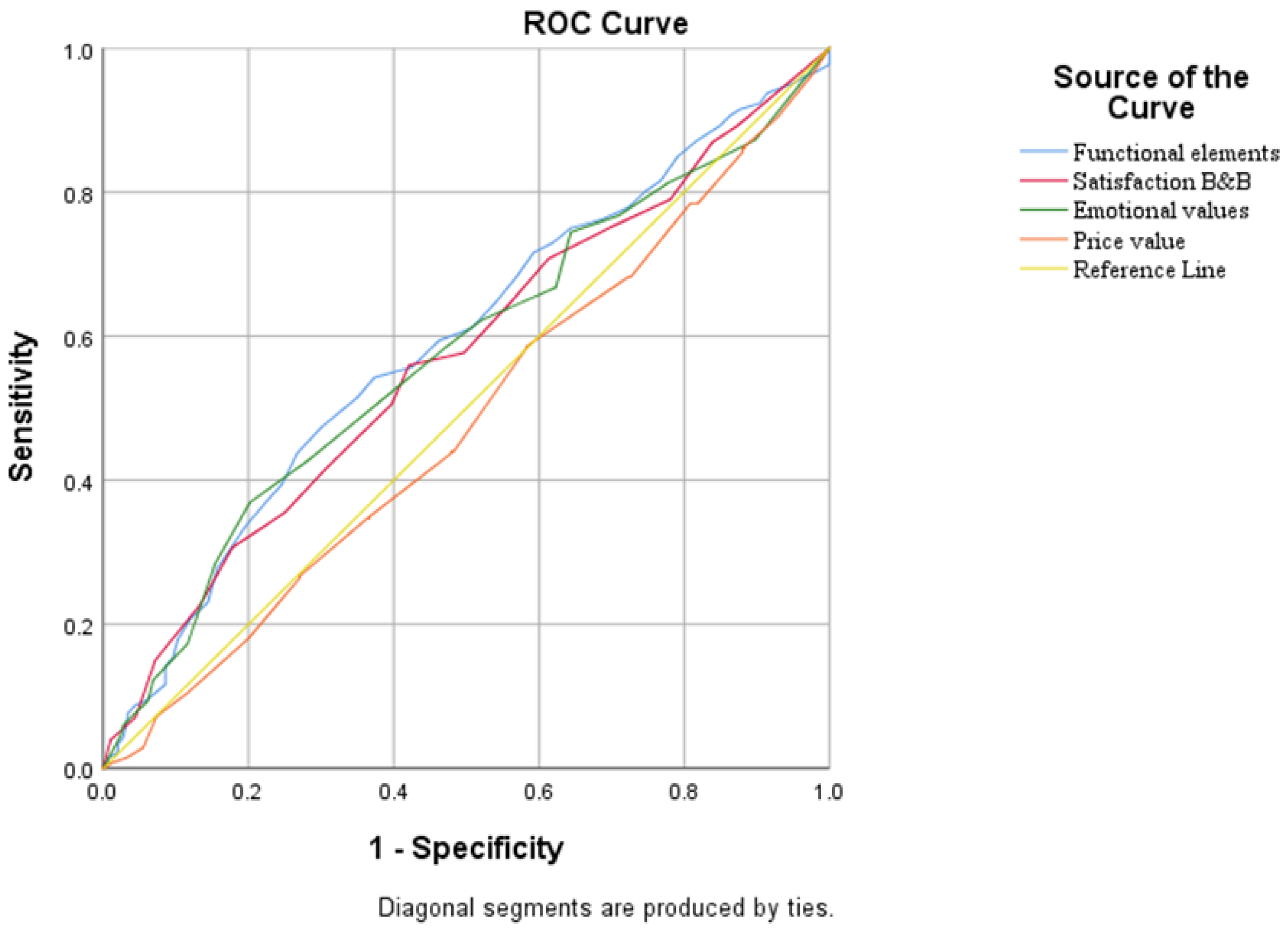
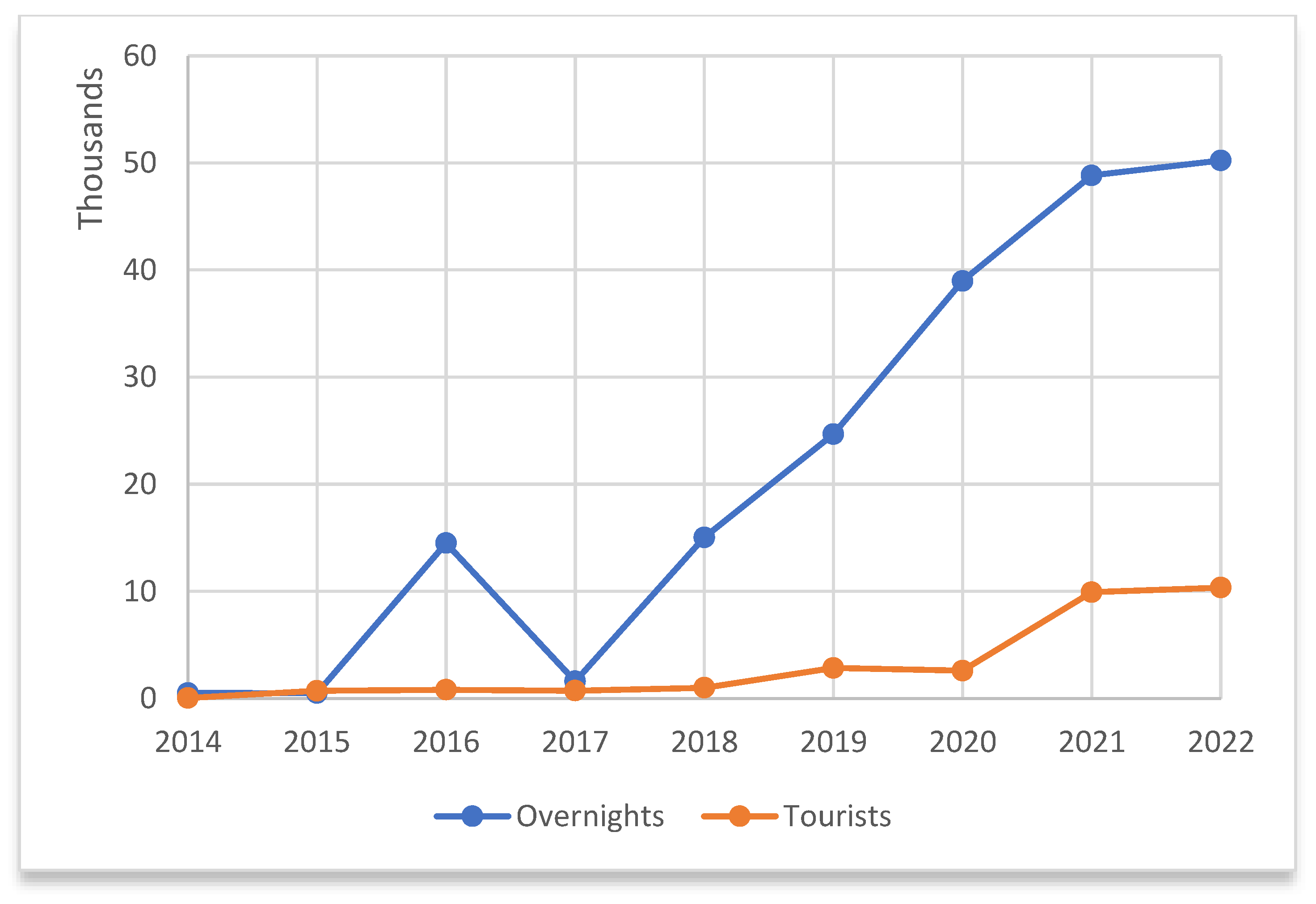
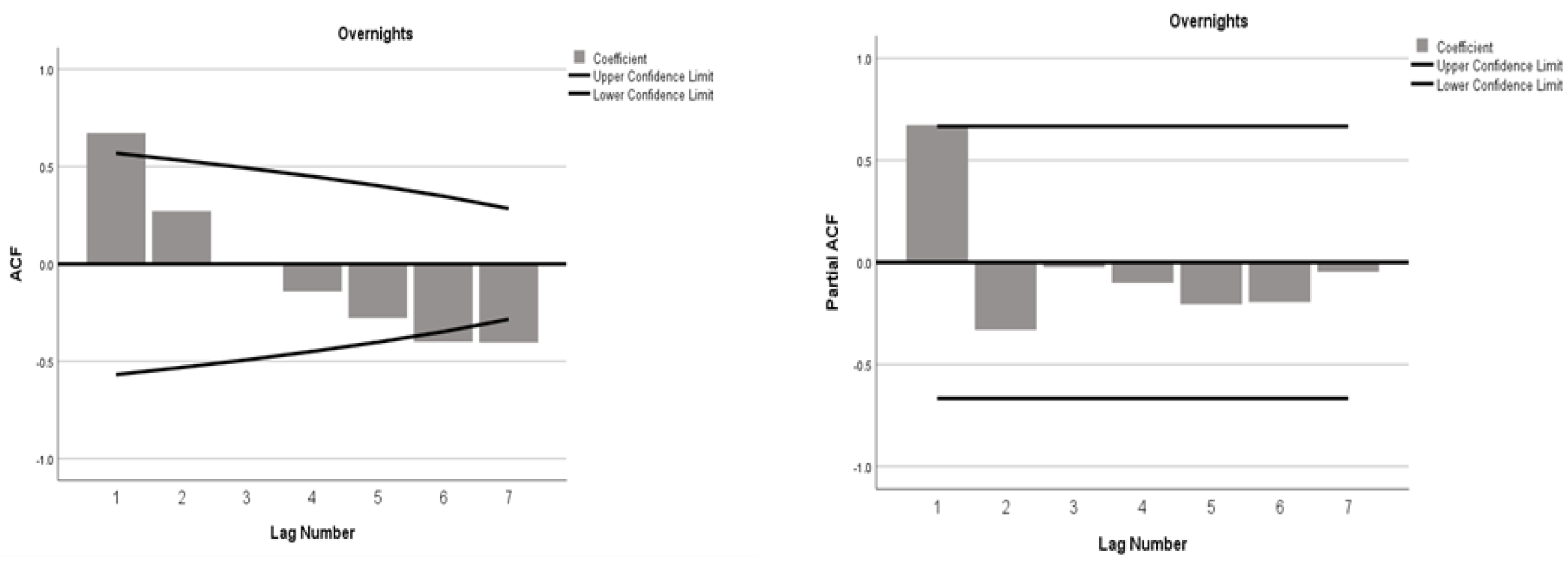

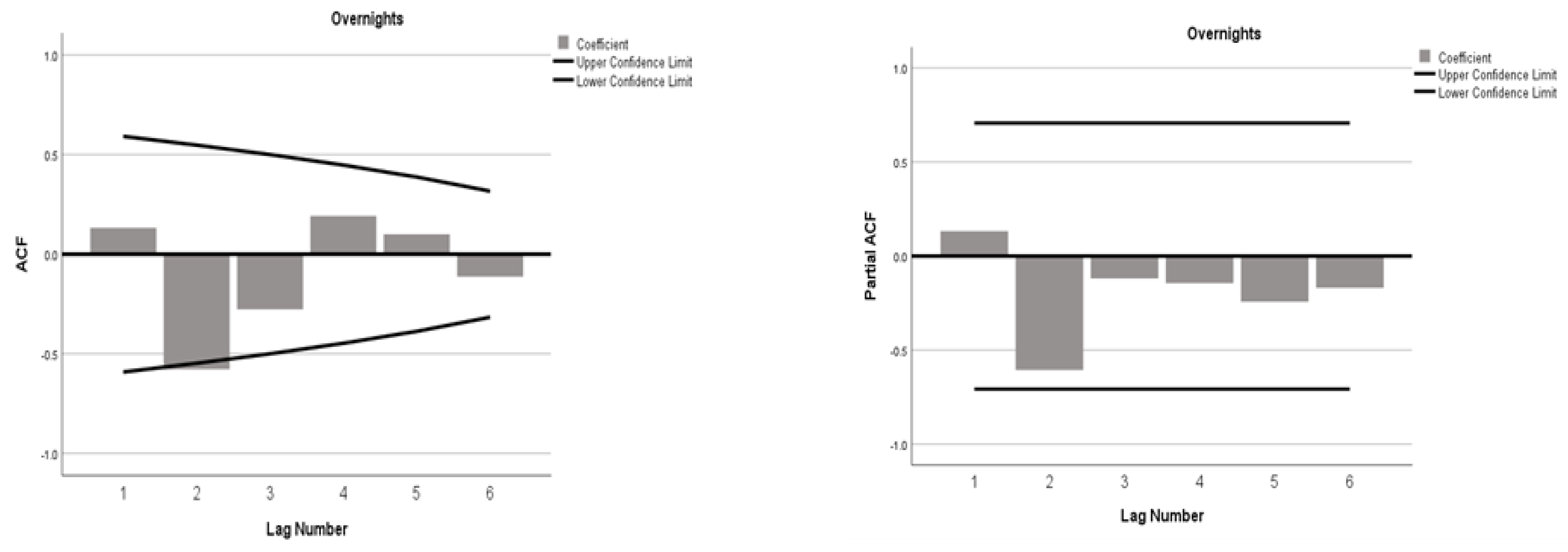
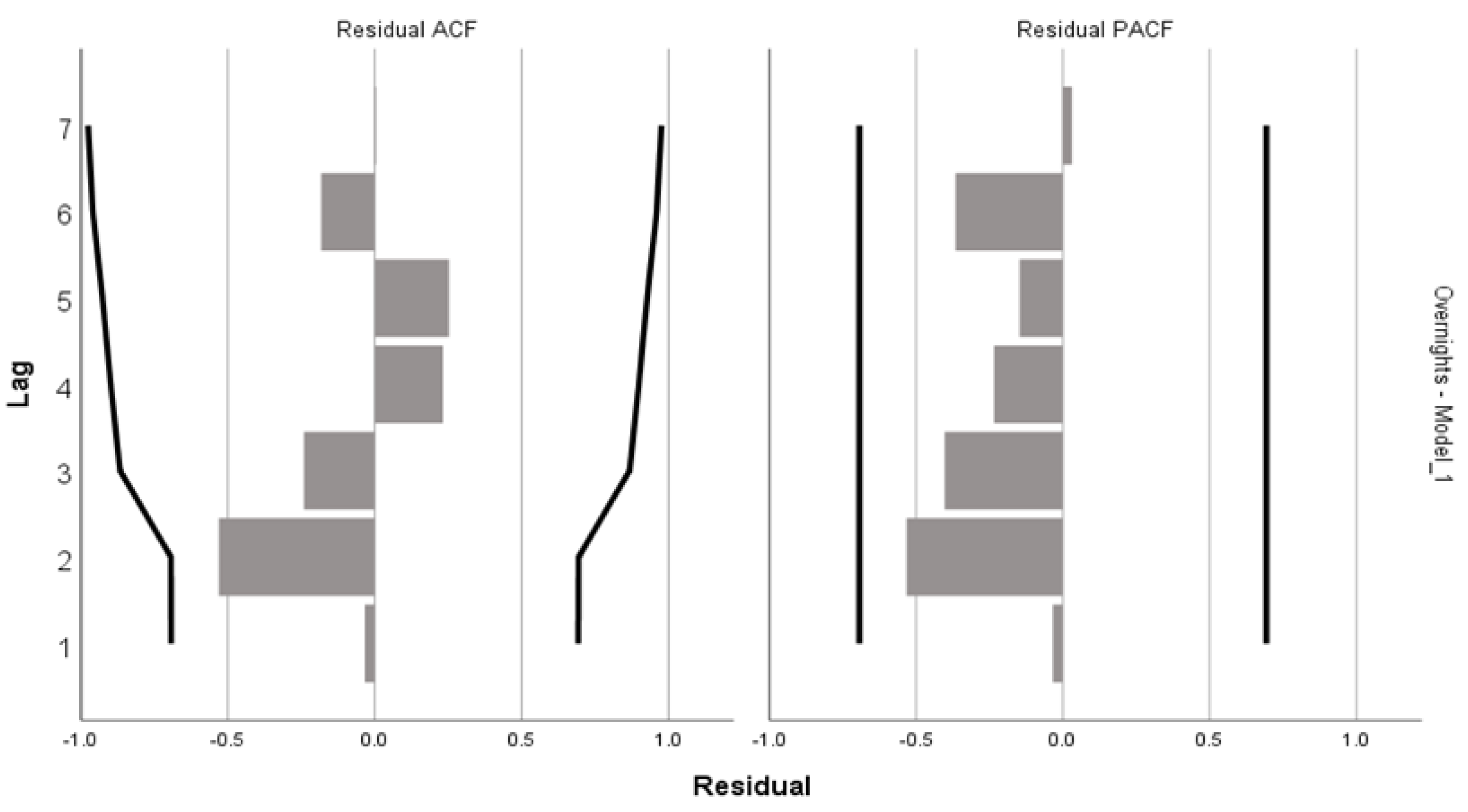
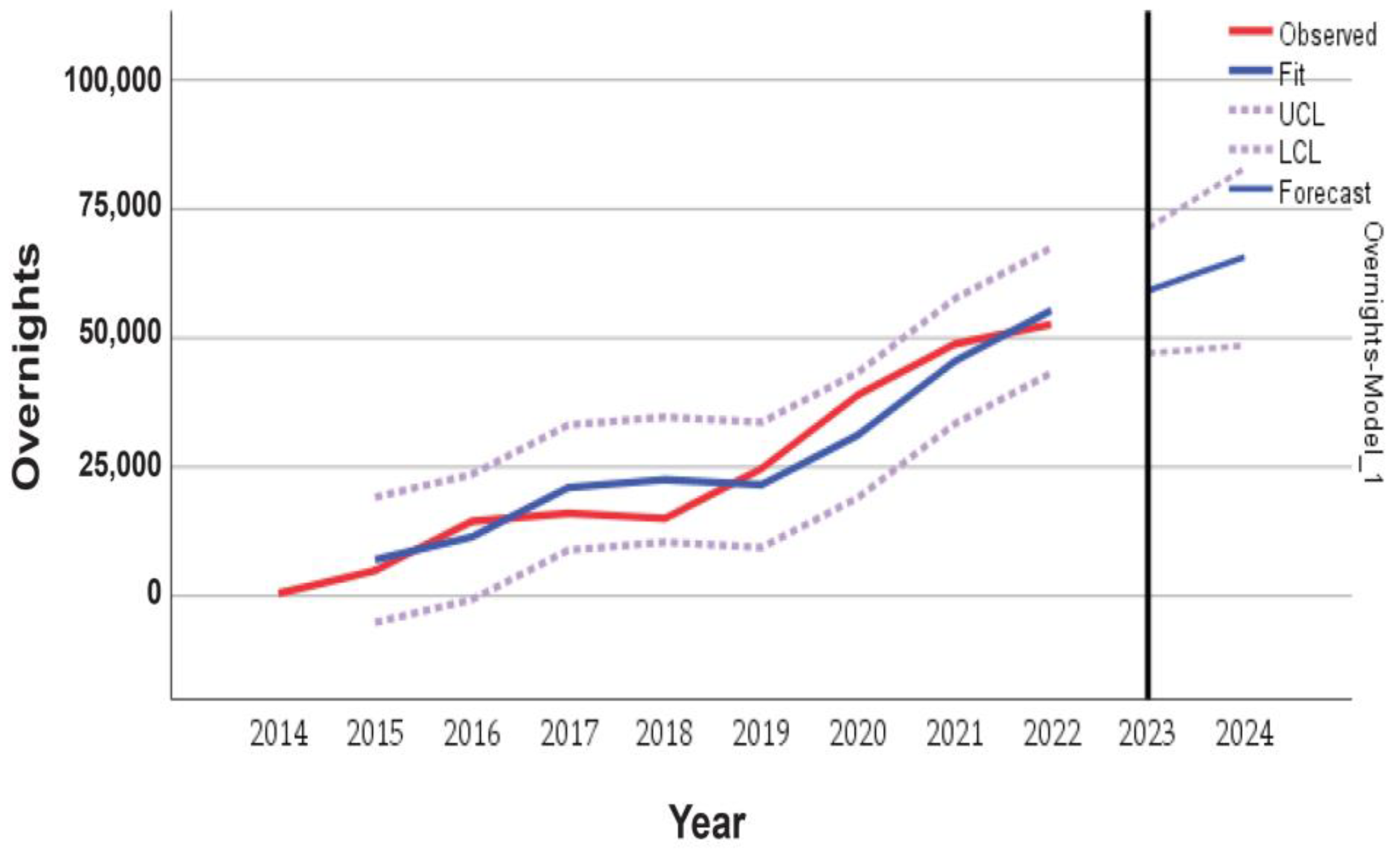
| Gender | Frequency of Traveling | |||||
|---|---|---|---|---|---|---|
| Female | 40.80% | I travel abroad several times a year | 37.11% | |||
| I travel abroad once a year | 21.03% | |||||
| Male | 59.92% | I have traveled abroad several times in my life | 41.86% | |||
| Education | Earning | |||||
| High school | 39% | Low (≤400 *) | 1.22% | |||
| Faculty | 40.80% | Average (400–700 *) | 34.04% | |||
| MSc, PhD | 19.30% | High (>700 *) | 64.74% | |||
| Age | Country of Residence | |||||
| 18–35 | 28.09% | North Macedonia | 2.11% | Austria | 7.30% | |
| Germany | 2.01% | Romania | 4.80% | |||
| 36–60 | 33.20% | Bosnia and Herzegovina | 31.20% | Montenegro | 12% | |
| Hungary | 3.90% | |||||
| >61 | 38.71% | Croatia | 11.70% | Bulgaria | 15.18% | |
| Slovenia | 6.70% | Australia | 3.10% | |||
| Indicators | Performance (mp*) | * Rp | Importance (mi*) | * Ri | Gap (mi-mp) | t-Value | * p-Value |
|---|---|---|---|---|---|---|---|
| F1-q1f1 | 3.97 | 17 | 2.00 | 23 | −1.97 | 25.843 | 0.000 |
| F1-q2f1 | 4.33 | 6 | 3.01 | 16 | −1.32 | 18.018 | 0.000 |
| F1-q3f1 | 5.49 | 1 | 2.25 | 20 | −3.24 | 42.523 | 0.000 |
| F1-q4f1 | 4.65 | 4 | 3.22 | 12 | −1.43 | 15.577 | 0.000 |
| F1-q5f1 | 4.99 | 3 | 2.92 | 18 | −2.07 | 21.010 | 0.000 |
| F1-q6f1 | 5.42 | 2 | 3.91 | 3 | −1.51 | 20.268 | 0.000 |
| F1-q7f1 | 4.22 | 10 | 3.32 | 11 | −0.9 | 8.208 | 0.000 |
| F1-q8f1 | 4.14 | 12 | 2.55 | 21 | −1.59 | 17.411 | 0.000 |
| F1-q9f1 | 4.03 | 15 | 2.15 | 22 | −1.88 | 19.420 | 0.000 |
| F1-q10f1 | 4.26 | 8 | 3.75 | 4 | −0.51 | 4.678 | 0.000 |
| F1-q11f1 | 3.96 | 18 | 3.94 | 1 | −0.02 | 1.206 | 0.837 |
| F1-q12f1 | 3.93 | 19 | 3.66 | 5 | −0.3 | 2.523 | 0.012 |
| F1-q13f1 | 3.82 | 20 | 3.13 | 14 | −0.69 | 6.901 | 0.000 |
| F1-q14f1 | 4.19 | 11 | 3.25 | 13 | −0.94 | 9.059 | 0.000 |
| F2-q1f2 | 4.51 | 5 | 3.93 | 2 | −0.58 | 5.653 | 0.000 |
| F2-q2f2 | 4.12 | 13 | 3.09 | 15 | −1.03 | 9.615 | 0.000 |
| F2-q3f2 | 4.03 | 14 | 3.50 | 9 | −0.53 | 5.154 | 0.000 |
| F3-q1f3 | 4.31 | 7 | 3.56 | 8 | −0.75 | 6.854 | 0.000 |
| F3-q2f3 | 3.99 | 16 | 3.40 | 10 | −0.59 | 6.252 | 0.000 |
| F3-q3f3 | 4.23 | 9 | 3.58 | 7 | −0.65 | 5.951 | 0.000 |
| F4-q1f4 | 2.82 | 21 | 2.77 | 19 | −0.05 | 4.484 | 0.628 |
| F4-q2f4 | 2.68 | 23 | 3.62 | 6 | 0.94 | −9.483 | 0.000 |
| F4-q3f4 | 2.75 | 22 | 2.98 | 17 | 0.23 | −2.049 | 0.041 |
| H1a: Foreign tourists positively assessed the quality of rural services ✔ | |||||||
| H1b: There was a low degree of gap between expected and perceived values of service quality ½ ✔ | |||||||
| Factors | AVE * | COMP * | Performance (mp*) | Importance (mi*) | Gap (mi-mp) | t-Value * | p-Value * | r * |
|---|---|---|---|---|---|---|---|---|
| F1-Functional elements | 0.659 | 0.964 | 4.39 | 3.05 | −1.34 | 33.227 | 0.000 | 0.146 |
| F2-Satisfaction elements | 0.640 | 0.842 | 4.22 | 3.50 | −0.72 | 8.871 | 0.000 | 0.184 |
| F3-Emotional elements | 0.642 | 0.843 | 4.18 | 3.51 | −0.67 | 8.729 | 0.000 | 0.219 |
| F4-Price value | 0.685 | 0.867 | 2.75 | 3.12 | 0.37 | −5.992 | 0.000 | −0.009 |
| Area Under the Curve | ||||||
|---|---|---|---|---|---|---|
| Test Result Variable(s) | Area | Std. Error | Asymptotic Sig. | Asymptotic 95% Confidence Interval | ||
| Lower Bound | Upper Bound | |||||
| F1-Functional elements | 0.590 | 0.022 | 0.000 | 0.546 | 0.634 | H2a ✔ |
| F2-Satisfaction elements | 0.570 | 0.022 | 0.002 | 0.526 | 0.614 | H2b ✔ |
| F3-Emotional value | 0.574 | 0.023 | 0.001 | 0.530 | 0.618 | H2c ✔ |
| F4-Price value | 0.480 | 0.023 | 0.384 | 0.435 | 0.525 | H2d ✖ |
| Model Fit Statistics | Ljung–Box Q (18) | ||||||
|---|---|---|---|---|---|---|---|
| R2 | RMSE | MAPE | BIC | Statistics | df | Sig. | Number of Outliers |
| 0.932 | 5925.398 | 16.303 | 18.414 | 26.633 | 17 | 0.10 | 0 |
| Model | 2023 | 2024 | Confirmation | |
|---|---|---|---|---|
| Overnights-Model_1 | Forecast | 53,525 | 61,626 | H3 ✔ |
| UCL | 69,144 | 92,940 | ||
| LCL | 37,907 | 30,311 | ||
Disclaimer/Publisher’s Note: The statements, opinions and data contained in all publications are solely those of the individual author(s) and contributor(s) and not of MDPI and/or the editor(s). MDPI and/or the editor(s) disclaim responsibility for any injury to people or property resulting from any ideas, methods, instructions or products referred to in the content. |
© 2023 by the authors. Licensee MDPI, Basel, Switzerland. This article is an open access article distributed under the terms and conditions of the Creative Commons Attribution (CC BY) license (https://creativecommons.org/licenses/by/4.0/).
Share and Cite
Gajić, T.; Đoković, F.; Blešić, I.; Petrović, M.D.; Radovanović, M.M.; Vukolić, D.; Mandarić, M.; Dašić, G.; Syromiatnikova, J.A.; Mićović, A. Pandemic Boosts Prospects for Recovery of Rural Tourism in Serbia. Land 2023, 12, 624. https://doi.org/10.3390/land12030624
Gajić T, Đoković F, Blešić I, Petrović MD, Radovanović MM, Vukolić D, Mandarić M, Dašić G, Syromiatnikova JA, Mićović A. Pandemic Boosts Prospects for Recovery of Rural Tourism in Serbia. Land. 2023; 12(3):624. https://doi.org/10.3390/land12030624
Chicago/Turabian StyleGajić, Tamara, Filip Đoković, Ivana Blešić, Marko D. Petrović, Milan M. Radovanović, Dragan Vukolić, Marija Mandarić, Goran Dašić, Julia A. Syromiatnikova, and Andrej Mićović. 2023. "Pandemic Boosts Prospects for Recovery of Rural Tourism in Serbia" Land 12, no. 3: 624. https://doi.org/10.3390/land12030624
APA StyleGajić, T., Đoković, F., Blešić, I., Petrović, M. D., Radovanović, M. M., Vukolić, D., Mandarić, M., Dašić, G., Syromiatnikova, J. A., & Mićović, A. (2023). Pandemic Boosts Prospects for Recovery of Rural Tourism in Serbia. Land, 12(3), 624. https://doi.org/10.3390/land12030624








